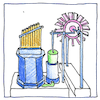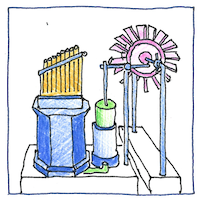Hero of Alexandria (Heron)
mechanics

|
Windmill
Hero of Alexandria, known also as Heron, invented machines that work on the pressure of air, steam, and water, or using a weight like a clock, a wind-powered organ, a fire engine with the first force-pump, automatic doors, a statue that poured wine, a ten-minute automated mechanical theatrical performance, the first coin-operated vending machine (dispensing holy water), a programmable cart, and the first steam turbine, a temple novelty, the aeolipile, powered by jets of steam.
Wonders
Heron intended his machines as toys, tools, and temple wonders. The gods of ancient Greece had already set a precedent. Hephaestus had made the winged helmet and sandals of Hermes, walking tripods, and the bronze man, Talos, who guarded the island of Crete.
Free wind
There’s no fee for putting the wind to work except for the ship and its mast, rigging, crew, and sails. There’s no fee except for someone to mind the mill and the millstone that it turns. There’s no fee; the wind is free, but windmills were all replaced with gas and steam engines.



It took a leap of the imagination to extend the idea of sails to power a stationary machine. Once you see it, however, it is easy to copy.
See also in The book of science:
Readings in wikipedia: